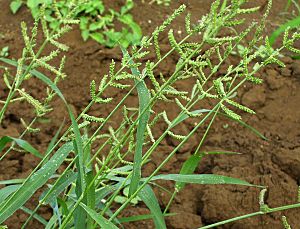Jungle rice facts for kids
Quick facts for kids Jungle rice |
|
|---|---|
 |
|
| Conservation status | |
| Scientific classification | |
| Genus: |
Echinochloa
|
| Species: |
colona
|
| Synonyms | |
|
|
Echinochloa colona, often called jungle rice, deccan grass, or awnless barnyard grass, is a type of wild grass. It first grew in tropical parts of Asia. This grass is the wild ancestor of a plant grown for food, called sawa millet.
Where Jungle Rice Grows
This grass can be found all over tropical Asia and Africa. It often grows in fields, along roads, and near water.
However, in places like the Americas and Australia, it is seen as an invasive weed. This means it spreads easily and can harm local plants. In Australia, it has moved into wetlands. There, it can threaten native plants like swamp tea trees.
Jungle Rice as Food
In India, people use the seeds of this grass to make a dish called khichadi. They often eat it during festival fasting days.
It has different names depending on the region:
- In Gujarati, it is called "Samo" (સામો) or "Moriyo" (મોરિયો).
- In Marathi, it is known as bhagar (भगर) or "Vari cha Tandul" (वरी चा तांदुळ).
- In Hindi, it is called "Mordhan" (मोरधन) or "Sava ka chawal" (सवा का चावल). It is also known as "samay ke chawal".
An old book from 1889, 'The Useful Native Plants of Australia', mentions this plant. It said that Aboriginal people used the seeds as food. They would grind the seeds between stones, mix them with water, and make a type of bread.
See also
 In Spanish: Echinochloa colona para niños
In Spanish: Echinochloa colona para niños


